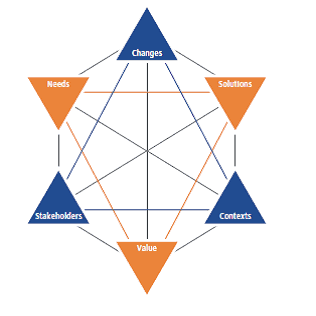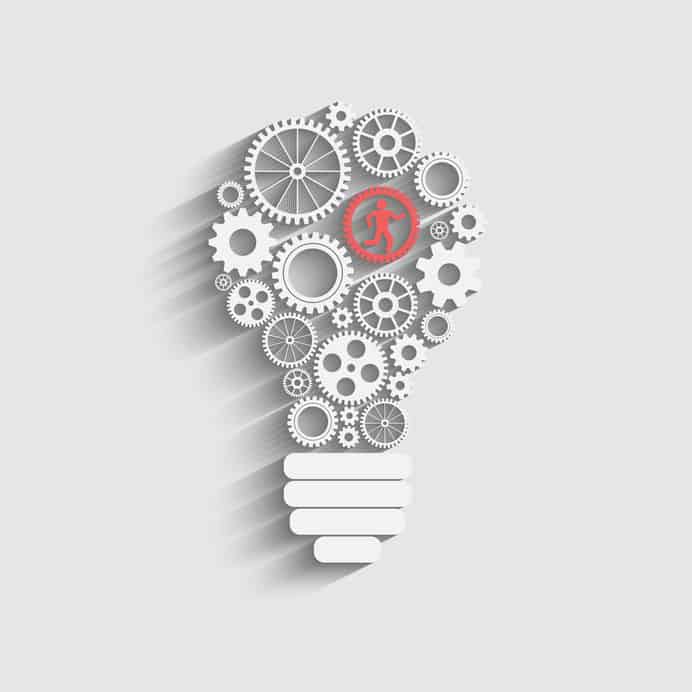In any area of expertise, identifying a shared terminology and developing an operational framework is necessary for successful cooperation between professionals and any other interested sides in said areas, as well as for providing clear communication between them. This is especially true in the field of business analysis.
The job of business analysts includes a tremendous amount of information, numerous tasks to be performed, and various relationships with associates both within the team and the organisation in question.
Having an established structure and precisely defined business analysis concepts allows the business analyst to make sense of the task at hand and accurately assess necessary resources, skills, and actions.
Table of Contents
BACCM (Business Analysis Core Concept Model)
The BACCM, defined by IIBA (International Institute of Business Analysis) and laid out in BABOK (Business Analysis Body of Knowledge) v.3
The BACCM defines the field of business analysis, enables the communication between all of the interested sides, helps determine and evaluate relationships between core concepts, and provides tools for interpretation of the impact and results of applied business analysis methods.

It’s important to notice that these concepts are not ranked or sorted in any way by value, nor is one more significant than the other. Proper business analysis implies a holistic approach to an organisational change, but also full attention to details which is only possible when all of the concepts are treated as equal and essential. The BACCM concepts do not exist in a vacuum, all six of them are defined by each other and mutually co-dependent. It’s hard to get a grasp of one of them without understanding others. A change to any of the key concepts inevitably requires a re-evaluation of the other five concepts and their mutual relationship.
Change
A change, in its essence, is an act of making something different. In business, this act, or transformation, occurs as a response to a need. The need for prompting this transformation can be internal or can be caused by external factors, such as market disruption, political climate, or natural disaster. The goal of a business analyst should be to implement changes in a way that will improve the functioning of an enterprise. Business analysts use business analysis techniques to control and carry out these improvements. The favourable transformation of an organisation should improve its value and help avoid any potential downfalls.
This may include preparing, provoking, preventing a change. Preparing the change requires the business analyst to ask questions regarding the object of transformation, the context in which the change will occur, the reason for it, and also to identify who will be interested in a change. The answers to these questions provide a foundation for successful transformation implementation.
Each change carries with itself certain benefits and disadvantages or costs. By provoking and discovering potential transformations, a BA can discover potential problems and discover which action will bring the most value. If, during the analysis, the BA determines that a certain change will bring the decrease in value, they try to prevent the change in question from happening or at least minimise its effects. This also includes providing the organisation with the capability to control itself.
Need
The need is a problem, opportunity, or constraint that needs addressing, basically something that the organisation requires. They are the result of the current state of the enterprise and the reason why a certain project even exists. Analyst’s job starts with needs and they guide the whole process. Needs are intertwined with changes. They motivate stakeholders to act, thus bringing on the changes. It also works the other way around; changes that decrease or increase the organisational value create new needs within the organisation.
Proper assessment of the needs can be crucial for the success of the project. Stakeholders often don’t distinguish between what they need and what they want, and it’s a business analyst’s job to precisely identify the real needs of the enterprise. By working with stakeholders, the BA should be able to determine if the real need can be satisfied at a much lower cost, for example, adding or improving the functionality of the software system instead of a full replacement. One of the essential parts of any project is educating all of the sides involved in the key characteristics of organisational needs and ways to meet them.
Solution
The solution is a means to solving a problem, i.e. satisfy the organisational need by creating, realising, exchanging, or storing value. The value is directly associated with the stakeholder’s need in a given context. The solution can resolve the stakeholder’s problem, help him seize an opportunity, enforce a constraint if so desired, or remove a constraint and allow certain activity.
There can be more than one solution to specific needs. Also, the same need may be addressed with different solutions in different organisations. Often, various stakeholders on the same project will prefer contrasting solutions to a specific problem. The business analysts have to balance these requests and take numerous factors, such as costs, benefits, or risks, into consideration when deciding on a solution.
The solution brings value by improving the functionality of a certain aspect of a stakeholder’s business, changing its characteristics, or enhancing the experience of either organisation or a customer. The implemented solution is successful only if it delivers value and fulfil the stakeholder’s needs. When that happens it’ no longer an objective or a need, but a part of the normal day-to-day operation of a business. It becomes a part of a new organisational environment and as such may produce new needs or changes. The organisational infrastructure itself is, in fact, a collection of existing solutions to existing needs.

Stakeholder
The stakeholder is an individual (or a group) that has a relationship to and wants to influence the change, the need, or the solution. The level of their involvement in a project varies. They can have different relationships and different impacts and influences on other core business analysis concepts. They are often grouped depending on their interest in certain aspects of a project and allocated the need, change, or solution. The need usually arises when one of the stakeholders expresses a wish or identifies a problem. They are also on the receiving end of solutions and changes and are the ones to whom value is delivered.
For every project, there should be a list of stakeholders that take participation or are affected by proposed solutions and changes. During the course of the project, the business analyst will most likely interact with most of them. Some of them will need training in using the new solutions and help getting used to the changes. If needed, the solution can be adjusted to make this process easier.
BABOK lists several categories of stakeholders depending on their role in the project. The list is not definitive, and some hold multiple subcategories, while some people may fill out roles within several categories.
- Business analyst
- Customer
- Domain subject matter expert
- End-user
- Implementation subject matter expert
- Operational support
- Project manager
- Regulator
- Sponsor
- Supplier
- Tester
Value
The value presents the worth or significance of something to a stakeholder. It is something that benefits the organisation in a certain context. Value can be positive, demonstrated in returns and improvements, but also, in some cases, negative when it comes in the form of losses or costs.
Of all business analysis concepts, this may be the hardest one to grasp. It’s difficult to clearly define value. The solution to the need brings both tangible and intangible value to the enterprise. Tangible values are measurable and can include savings and profits, while intangible ones include morale boosts or an increase in the organisation’s reputation. The value is not always absolute, it can be subjective and more valuable for one set of stakeholders than to the other. For example, the same solution may not bring the same value to the sales department and the customer support.
Context
The context is a set of circumstances that create an environment where a change takes place. It influences, is influenced by, and helps us better understand the said change. The context is a crucial part of a project that BAs should consider since all of the changes and proposed solutions take place within a space with existing processes and systems. Understanding how a new solution will work within that set environment can make or break the project. The context helps determine what’s relevant to the project and provides a setting for stakeholders to communicate and identify their relationships to the changes and solutions. Different stakeholders may operate in varying contexts, but for a business analyst, they are all equally important.
The context is defined by its inner and outer boundaries. Inner boundaries define the scope of change, while outer ones determine what is relevant to the change. Basically, the context is everything that influences the change, except for the change itself. BABOK list several things, influences, and circumstances that determine the context: behaviours, culture, competitors, government, infrastructure, products, sales, weather, technology, terminology, and many others. The context is by no means static. It can change cyclically or randomly.
Conclusion
The business analysis core concept model (BACCM) provides a framework to understand the six fundamental business analysis concepts: change, need, solution, stakeholder, value, and context. The BACCM provides a core basis for business analysis understanding and a platform to develop knowledge.
You should seek opportunities in your projects to gain practical experience of these concepts and develop skills in the business analysis techniques


